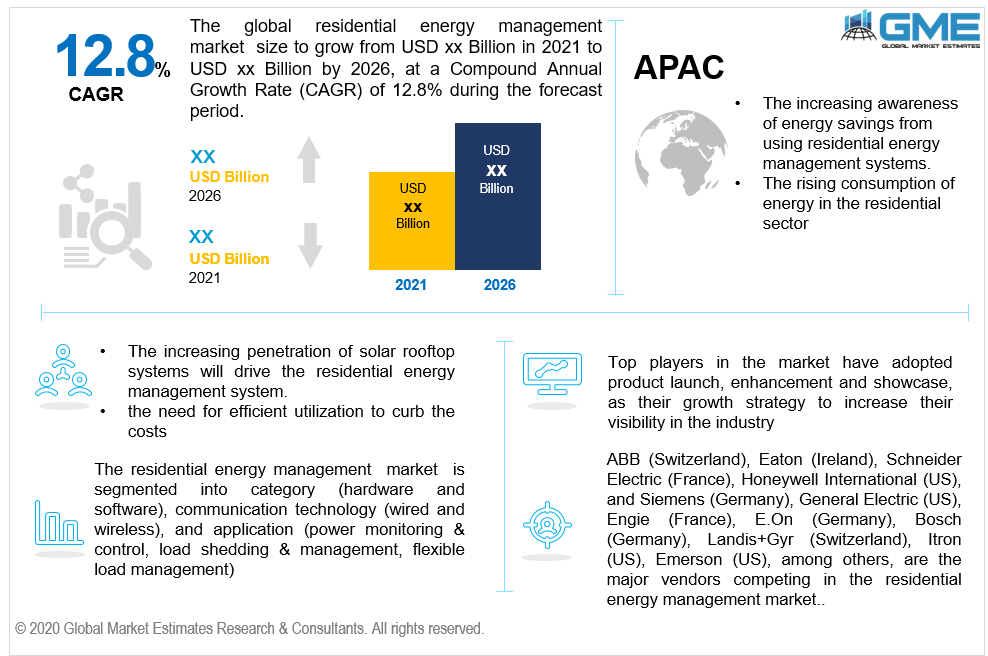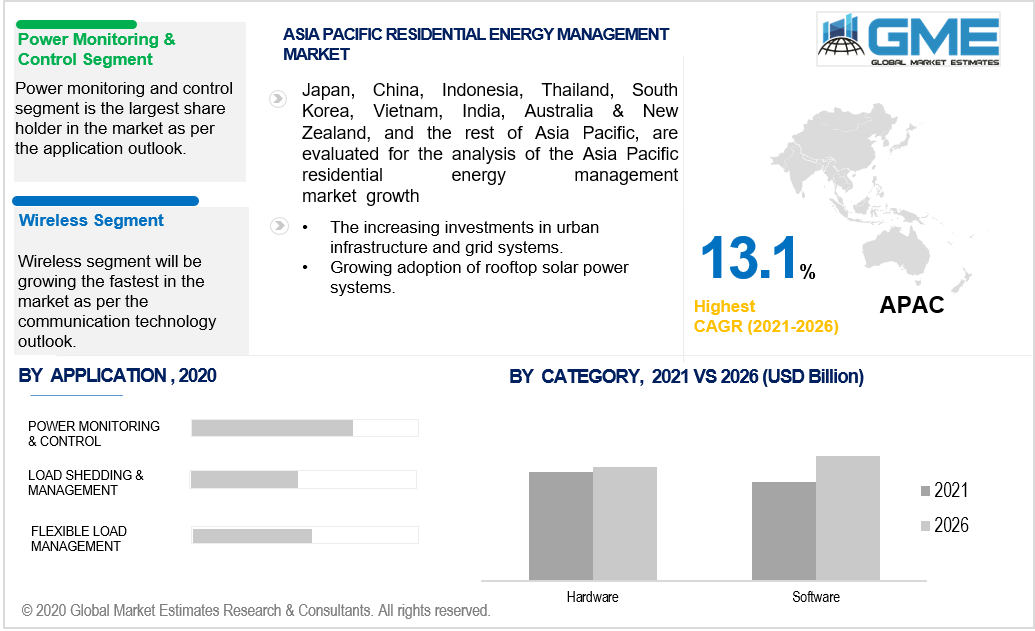
Global Residential Energy Management Market Size, Trends, and Analysis - Forecasts To 2026 By Component (Hardware [Remote Terminal Units, Relays, Load Control Switches, Demand Response Devices, Control Devices, In- house Displays], Software [Energy Management Platform, Energy Analytics, Customer Engagement Platform]), By Communication Technology (Wired [Fiber Optic, Ethernet, Powerline Carrier, IP], Wireless [Radio Frequency Mesh, Cellular Network, WiMAX]), By Application (Power Monitoring & Control, Load Shedding & Management, Flexible Load Management), By Region (North America, Asia Pacific, CSA, Europe, and the Middle East and Africa); End-User Landscape, Company Market Share Analysis & Competitor Analysis
The demand for residential energy management systems is increasing globally as homeowners are beginning to implement battery storage and small-scale solar power generation units in their properties to make electricity consumption more efficient and cheaper. Residential energy management systems are hardware and software-based systems that are capable of monitoring energy production and consumption and controlling them both manually and automatically in residential properties. The hardware acts as the communication hub between the user, the energy consumption and production, and in some instances the utility provider. The software acts as the interface for the user to control the energy production and consumption within the household. As the global population increases, the energy production has to also match the increased consumption but our resources are limited. In the US, 21% of the electricity produced is consumed by the residential sector and the number is estimated to be 18% globally by the US Energy Information Administration (EIA), to reduce consumption governments are increasing electricity tariffs and incremental tariff models. Residential units are turning to solar energy to reduce energy consumption costs which have increased the demand for smart residential energy management systems in the market. Governments have been incentivizing the implementation of solar power, and energy management systems to reduce energy consumption. Governments are implementing smart grid systems and improving existing grids which decreases the cost of implementing residential energy management systems. Governments are increasing investments in urban infrastructure development especially in the APAC region. The market is driven by new technology, increased implementation of small-scale rooftop solar power generators, government incentives and investments in grid infrastructure, and increased demand from homeowners to reduce energy consumption through smart monitoring systems. The market is restrained by the high initial cost, need for infrastructure in case of grid-connected systems, privacy concerns among homeowners, and a lack of awareness of residential energy management systems.

Based on category, the market is divided into hardware and software. The hardware segment includes remote terminals, relays, load control switches, control devices, in-house displays, and demand response systems. The software segment includes energy management platforms, energy analytics, and customer engagement platform. The hardware system acts as the hub that relays information between the user, and the consumption and generation patterns in the household. With recent advancements in communications technology, there has been an increase in cloud-based systems that are more dependent on software. The software acts as the interface, monitors, and analyses the data. The software segment will grow with the highest CAGR during the forecast period as cloud-based systems are becoming the norm owing to their ease in connectivity, faster data transfer, and increased accessibility.
According to the communication technology used in the residential energy management systems, the market can be segmented into wired and wireless segments. The wired segment included fiber optics and ethernet, among others while the wireless segment includes cellular networks, WiMAX, and radiofrequency mesh. The wireless segment will grow with the highest value of CAGR while the wired segment held the largest share from 2021 to 2026. Wired residential energy management systems are the most common communication type as they’re relatively easier to use, capable of transferring large amounts of data with no interference or lag, and heightened security. Recent advancements in wireless technology have improved the data transfer rates, security of wireless systems, they also make it possible for the homeowner remote access to the system all of which are expected to drive the market for wireless for residential energy management systems during the forecast period.
Based on application, the residential energy management market systems are segmented into power monitoring and control, load shedding and management, and flexible load management. The power monitoring and control segment will hold the lion’s share in the residential energy management market. The need for power monitoring and control is the greatest in the residential energy management systems market. Households are mainly looking to improve consumption efficiency, monitor usage rates, and production in the case of solar power-enabled systems. Flexible load management is expected to grow at the fastest rate during the forecast period, as such systems reduce the load on grids during peak hours and increase savings on electricity consumption.

As per the regional understanding, the Asia-Pacific region will grow with the highest CAGR value and the North American region will be a dominant regional segment. The North American region is driven by the increased adoption of rooftop solar power systems in the region. More than 6% of homes in the US have installed rooftop solar systems as of 2019, this number is expected to increase significantly during the forecast period. The government in the region incentivizes the usage of the energy management system and there is an increasing awareness among the public about the consumption cost-effectiveness of using such systems in their homes. The APAC region is driven by the increased investment in grid infrastructure development as countries like China and India are beginning to invest heavily in urban development. The growing cost of electricity consumption in the region is expected to increase the demand for residential energy management systems in the region during the forecast period. Governments are also incentivizing the usage of solar power in residential systems and they’re introducing smart grid systems that are making residential energy management systems more feasible.
ABB (Switzerland), Eaton (Ireland), Schneider Electric (France), Honeywell International (US), and Siemens (Germany),General Electric (US), Engie (France)ac, E.On (Germany), Bosch (Germany), Landis+Gyr (Switzerland), Itron (US), Emerson (US), Trane Technologies (Ireland), Tantalus system Corp, (US), Provident Energy Management Inc. (Canada), Sunverge Energy Inc.(US), Koben System Inc. (Canada), NeoSilica (India), Lockheed Martin Corporation (US), Uplight (US), Span.IO (US), Lumin (US), RacePoint Energy(US), Appartme (Poland), and Wattics Ltd (UK),among others,are the majorvendors competing in the residential energy managementmarket.
Please note: This is not an exhaustive list of companies profiled in the report.
We value your investment and offer free customization with every report to fulfil your exact research needs.
The Global Residential Energy Management Market has been studied from the year 2019 till 2026. However, the CAGR provided in the report is from the year 2021 to 2026. The research methodology involved three stages: Desk research, Primary research, and Analysis & Output from the entire research process.

The desk research involved a robust background study which meant referring to paid and unpaid databases to understand the market dynamics; mapping contracts from press releases; identifying the key players in the market, studying their product portfolio, competition level, annual reports/SEC filings & investor presentations; and learning the demand and supply-side analysis for the Residential Energy Management Market.

The primary research activity included telephonic conversations with more than 50 tier 1 industry consultants, distributors, and end-use product manufacturers.

Finally, based on the above thorough research process, an in-depth analysis was carried out considering the following aspects: market attractiveness, current & future market trends, market share analysis, SWOT analysis of the company and customer analytics.

Tailor made solutions just for you
80% of our clients seek made-to-order reports. How do you want us to tailor yours?
OUR CLIENTS